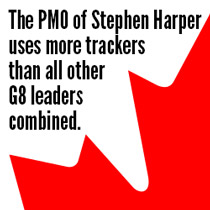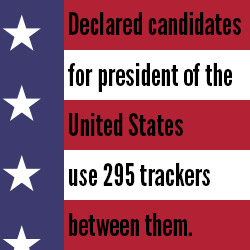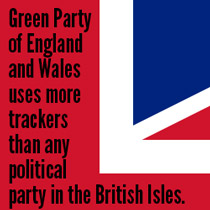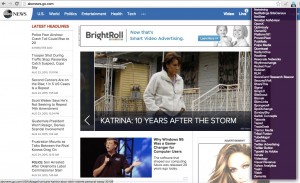Exclusive Tomorrow investigation examines 1,113 trackers used by 163 political parties and candidates around globe
Tracking, by artist in residence Jason Skinner. Creative Commons Attribution-NonCommercial-ShareAlike 4.0 International.
Political party and campaign websites are tracking voters with up to 52 different pieces of code, a Tomorrow investigation has found.
Some countries show huge variation between the largest parties as each compiles information on visitors or tracks them around the internet.
Green parties have more than other parties combined in Canada, Chile, Brazil and England and Wales, while Labour parties top lists in Scotland, Australia and New Zealand for use of trackers, which are facilitated by cookies and other coding.
A crowded United States presidential race is using almost 300 trackers between them, with an additional 272 coming from some of the biggest Super PACs (political action committees) as campaigns get more sophisticated.
And in Canada, currently in the midst of a national election campaign, the official website of the prime minister loads more trackers, many of them from advertising and marketing firms, than the other G8 leaders combined.
Even world bodies show significant differences, from the United Nations using just two trackers to the United Nations High Commissioner for Refugees (UNHCR) deploying up to 21 when you load their website.
Major spy agencies already being scrutinised for their surveillance of personal data, officially use no trackers or two at most.
Diego Naranjo, advocacy manger with the European Digital Rights (EDRi),1 said: “Regardless of people understanding or not what cookies are and how they function, people do not have a real choice rather than press ‘accept’ if they want to continue accessing a website.
“Politicians and anyone else using tools to count visitors should use tools which do not allow them to identify individuals.”
And former chief electoral officer of Canada, Jean-Pierre Kingsley,2 said the use of data may need to be reviewed after the election.
But political watchers in the US said no campaign could do without technology and none would “unilaterally disarm”.
Tomorrow used privacy browser extension Ghostery3 to examine 163 political websites across 25 countries, as well as another 70 from international organisations, banks and news media.
The free extension allows visitors to see how much tracking code is found on any website you use, and switch them off.
Trackers serve a variety of functions, from counting the number of hits to a site, to enabling social media plug-ins for comment sections, to following the public around the web, allowing advertising to be targeted and re-targeted to them based on their browser history.
Almost all websites – including Tomorrow – employ at least one basic analytics tool to count visitors. And some sites can load ads or trackers via linked accounts, such as YouTube videos, outwith the control of the sites themselves.
But how many are needed on political websites? How is data being used and how aware are voters? And is new technology the only way for smaller or opposition parties to get to voters?
Top 10 political parties for number of trackers
- Bahujan Samaj Party (BSP), India – 26
- Australian Labor Party – 25
- Tied: Green Party of Canada / Green Party of England and Wales – 22
- Eesti Reformierakond, Estonia – 21
- Tied: Movimiento Ciudadano, Mexico / Fratelli d’Italia (FdI), Italy – 19
- Republican National Committee – 18
- Scottish Labour Party -17
- Tied: Scelta Civica (SC), Italy / Propuesta Republicana, Argentina / Muttahida Qaumi Movement, Pakistan / Welsh Labour Party – 16
- Accion Democratica, Venezuela – 15
- Partido Verde, Brazil – 14
View the Google Spreadsheet HERE or click the icon below to download a zip file of the spreadsheet and all 314 screen grabs
Ian Koski, adjunct professor at George Washington University’s graduate school of political management teaching digital strategy,4 said most campaigns will use the technology to get a second chance to reach voters once they’ve clicked elsewhere.
“The use of internet technology is now ubiquitous,” he told Tomorrow by phone. “You have to do it, no matter what race you’re running here in the United States and increasingly internationally. It depends very much on internet penetration, broadband penetration and people’s comfort level. Here in the US though, digital is an absolutely fundamental part of just about every electoral campaign.
“What you do with it though could be anywhere on a pretty wide scale.
“The reality is, though, that no-one’s going to unilaterally disarm and not employ the types of re-marketing technologies and targeting technologies that could be what allows them to reach the right number of volunteers or donors or voters to win their election.”
Select a link below for more detail or continue reading
In almost all the countries surveyed, the main political parties or those with legislative or executive power, do not have the most trackers on their websites. It is usually opposition and in particular smaller parties deploying the technology.
While left-wing parties lead the field in many countries such as Scotland, Australia, New Zealand and Israel, conservative parties are top in France, Argentina and Turkey.
In only four countries surveyed are the parties currently in government using the most trackers, in Estonia, Wales, Turkey and Tunisia. Germany and Nigeria are the only countries with equal use across all examined homepages, with German parties using just one each.
Other nations show less developed deployment of trackers, with just one between three main parties in Kenya, for example.
Union websites, banks, world sporting bodies and others all use varying numbers of trackers on their homepages. Most official government websites have just one or two pieces of tracking code. Spying agencies such as MI5, the NSA and the CIA – who have been embroiled in controversy over the extent of their high-tech surveillance – have none or one.
But the number of trackers on political websites is minuscule compared to those used by the media, with several approaching or beyond 100 different trackers. Some sites have so many that they drag the loading of pages for several seconds with developers increasingly being aware of so-called “bloat” on site design.
Tomorrow only considered website homepages, which can show significant variation in the number of trackers from visit to visit and differ even more within a site, such as individual news article pages.
Ghostery, whose press representative declined to comment for this story, details about 2,000 trackers in existence, breaking down broadly as:
- advertising – a tracker that shows you ads
- analytics – one which counts visits and general location, browser and other information for websites
- beacons – single-pixel, clear images used to watch behaviour, known as “attribution measurement”; they are also used to determine if someone has opened and seen an email you’ve sent
- widget – these can range from “share” buttons or comments sections
Some cookies have been found with duration periods of almost 8,000 years compared to an average of one or two, with a quarter of websites not offering notice of use of them and more than half not seeking prior consent of the user, according to EDRi.
While European legislation requires websites notify users about the use of cookies and consent to their use,5 rules vary around the globe with many sites assuming consent based on use. Most privacy rules will apply to certain uses of information, such as medical records, or rely on self-regulation across an industry or within individual organisations.
In the other direction, data is being pushed to not only help media publishers gain income from clicks and site visits, but also as law enforcement experiment with “predictive policing”. New York City Police Commissioner William Bratton recently declared that using data to calculate potential locations, victims or perpetrators of crime, was the “wave of the future” and already a reality.6
EDRi warned that unless someone is using Ghostery, Privacy Badger, Disconnect or other browser plug-ins, there is no way to know if you are being tracked.
Seth Ulinski, a senior analyst covering advertising and marketing technology at US-based TBR (Technology Business Research, Inc)7 explained there were a number of types of data collection, tracking and functions.
“If you’re a publisher,” he told Tomorrow by phone, “you’re really looking to monetise your audience. Creating content takes work and good content doesn’t just grow on trees – people need to produce it, it’s a business.
[Tweet “”Good content doesn’t just grow on trees – people need to produce it, it’s a business.””]”News sites, other media owners, publishers, etc, having a better understanding of their audience allows them to then go to advertisers and say, ‘Hey, now we can prepackage different audience segments and deliver more value to you versus you’re going to buy a run of site and target everybody who comes to our site’.”
Dr Jason Turner, lecturer in advertising at the Dundee Business School at the University of Abertay,8 said everyone was “obsessed with measurability” and advertisers want to reach customers as directly as possible.
“Re-targeting has proved to be a useful online strategy and will continue to grow, targeting browsers based on their identity and specific buying behaviours,” he explained. “The advertising content on websites will continue to be re-marketing across social media channels to connect and re-connect to existing and potential purchasers alike.
“However, advertisers cannot lose sight of the fact that relevant and engaging content is integral to successful digital campaigns, whether that is through consumers driving the advertising content or the advert being integrated in an appropriate way into a consumers social identity and social timeline.”
A web user can be an advertising target based on being part of a market segment or based on their interests from surfing the web, whether they have signed up to a particular service or just by their search engine history. But if web users don’t feel content is relevant, they will switch off, Dr Turner insisted.
Mr Ulinski said that while industry bodies such as Internet Advertising Bureau (IAB) and Network Advertising Initiative (NAI) explain how re-marketing or re-targeting work, the other side of the argument is that trackers shouldn’t be used at all.
“It is a high-wire act as far as giving people notice and choice but not to the detriment of being able to analyse and do all the smart marketing that advertisers are looking to do,” he continued.
“So far the industry has done a pretty good job of self governing. But as far as do consumers understand? I think they know a lot more now than they did maybe three years ago, particularly with something like re-marketing or re-targeting. They might not get all of the mechanics behind it, but I think at that level people definitely have a better understanding as far as why things are going on.”
As the level of awareness increases, so does the number of people switching on ad blockers. Ad blocking software is estimated will cost $22 billion US dollars to publishers this year, with a report by PageFair claiming 198 million people worldwide are now using such tools. That number is up 41 per cent in a year and more ad blocking possibilities are on the way.9
So how much responsibility lies with a website publisher, such as a political party or candidate, and how much with the voter or web user?
Ian Koski, at George Washington University, said trackers don’t exist in isolation in political campaigns and the question is how digital technology broadly is used. And while internet users should be paying attention to such issues, many don’t care.
“They assume that the bounds of their privacy are being tested and most of the time it’s for convenience,” he said. “It’s tough to limit that, tough to regulate that. Privacy is a difficult line to walk.
[Tweet ““The bounds of their privacy are being tested and most of the time it’s for convenience.””]“How you use those platforms, how they link together, how they talk to each other, how your Facebook followers are pushed to join your email lists and how your email subscribers are pushed to take other actions. That’s really where the digital space has moved.
“It’s not necessarily just about inventing a new platform or getting on a new social media site – it’s about coordinating all of those investments and tactics and leveraging them for actual electoral outcomes. It’s the strategy that’s getting more refined and what we’re seeing is websites that are coded in a more sophisticated way to take advantage of those strategies, that work together.”
Mr Ulinski said as more people move to mobile devices, which don’t easily support third-party cookies and trackers, the identity of the devices themselves will be more important.
“Instead of a line of code or ‘cookie’ being stored on the consumer’s computer, a non-personally identifiable (non-PII) device ID is assigned and saved on ad tech platform of the publisher, advertiser, or agency,” he explained. The trackers used on desktops will decrease as new options rise.
With technology inevitably moving so quickly and the ability to reach voters changing constantly, can legislation keep up? Should it?
Diego Naranjo with EDRi said legislation usually follows what society needs, but what society needs to do is “adjust law and reality as soon as possible”.
“In an era when technology has gone far from what most people would expect only a few years ago, we need to develop policies which tackle these new issues around technology in the best way possible,” he told Tomorrow by email. “In particular in the field of privacy this means having policies which are effective, suitable for the technologies that exist and that may develop in the future, and be long-lasting policies.
“We are living in a crucial time for privacy not only for our generations but for those to come. The way we define privacy now will define how private we will be allowed to be in the future.”
But Jean-Pierre Kingsley said society and governments could only react if a problem was proven to exist. Comparing it to allowing smoking in public places or driving regulations, he said bluntly that people die before rules change to adjust to new realities.
“We let people smoke all over the place and then we have to try to find out how do we cut that back,” he said. “It’s like the telephone: we find out we’re killing more people by letting drivers talk or text on the phone while they’re driving than we are with alcohol and then we say, ‘Okay that’s a problem we have to solve’.”
This work is licensed under the Creative Commons Attribution-ShareAlike 4.0 International License.
Update August 28, 2015: Alliance Party of Northern Ireland was missed out and has now been added to the spreadsheet and total.
CORE PRINCIPLES APPLIED
No relevant issues on principles 1, 2, 4, 5, 7, 9 or 10.
3. Independence and accountability: Tomorrow publishes its Google Analytics data regularly and we remain open to any and all questions about how we use trackers and plug-ins.
6. A duty to openness: This feature and the spreadsheet analysis includes this website as we must be open about our own use of trackers, even as we examine their use by others.
8. Be a safe harbour for the public and staff: Tomorrow is looking to upgrade to https and at switching from Google Analytics in the coming months to Piwik so we maintain more direct control over collected statistics about site visits, thereby meeting the requirements of this principle.
11. Promote responsible debate and mediation: How many trackers are enough? Which ones are appropriate? Should political parties use them differently from businesses? Is more transparency required? Or education of the public?
- European Digital Rights, which uses no trackers. ↩
- Archived Elections Canada page on Mr Kingsley, no trackers deployed. ↩
- Headquartered in the US, Ghostery shows three trackers on its homepage. ↩
- Ian Koski’s GWU profile page, with three trackers. ↩
- European Commission details on cookies – with one tracker. ↩
- New York Times video of the speech, with two trackers ↩
- Profile page Seth Ulinski, with 1 tracker ↩
- Profile page of Dr Jason Turner, with five trackers. ↩
- PageFair report available here, with 19 trackers ↩





